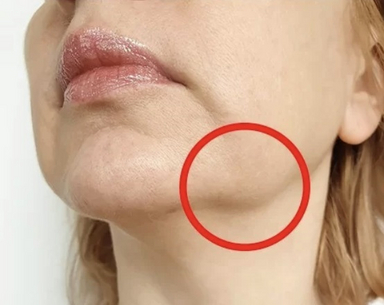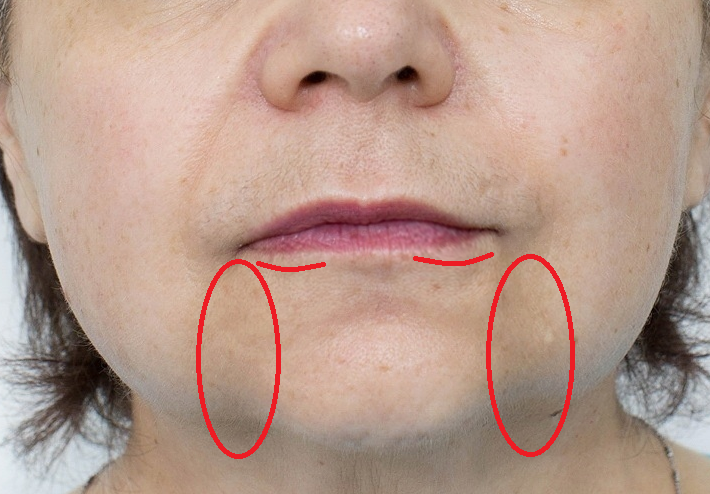The appearance of age-related changes on the face is inevitable throughout life. Wrinkles, dryness, and loss of skin tone are minor signs of ageing. The drooping oval of the face, neck, and appearance of jowls make the face look old and tired. Preventing their occurrence and removing existing jowls becomes possible with myofascial massage.
Table of Contents
What are Jowls?
Jowls are sagging areas of skin and subcutaneous fat in the lower third of the face. Their appearance is due to age-related changes in the body, specifically gravitational ptosis. Ptosis is characterised by sagging soft tissues, heavy and flaccid masticatory muscles, and loose skin. The foundation for the formation of jowls is laid between the ages of 21-25, when the synthesis of the body’s collagen, elastin, and hyaluronic acid begins to slow down. This weakens the overall framework of the skin. The outline of jowls appears between 35-40 as moderately drooping tissues. At 45-55 years old, “bulldog” cheeks become noticeable to the person but not to others. After 55, the signs of age become obvious.

Causes of Jowls
- Aging: As we age, all structures of our face change. The skin becomes less elastic, the elasticity of the ligaments that retain tissue deteriorates, the volume of superficial fat pockets increases, and they begin to fall under the influence of gravity. Additionally, the volume of the deep fat layer decreases and changes occur in the bony facial skeleton, enhancing this displacement. The result is a loss of facial definition and the formation of folds under the lower jaw.
- Genetics: The appearance and timing of pronounced cheekbones also depend on genetic predisposition, anatomical features of the facial structure, and type of aging.
- Excess Weight or Sudden Weight Loss: Both excessive fat deposition in the face and neck area and rapid loss of large amounts of subcutaneous fat can lead to the formation of jowls. Rapid weight loss does not give the skin enough time to adapt to new tissue volumes.
- Hormonal Imbalance: Estrogen deficiency in women reduces the production of elastin, collagen, and hyaluronic acid necessary for skin elasticity. Disturbances in thyroid hormone production can lead to swelling, promoting the formation of jowls.
- Dental Problems: Tooth extraction and incorrect implant installation can lead to jaw deformation and changes in the function of facial muscles, causing sagging tissues and the appearance of jowls. Untreated gum disease and tooth decay can provoke inflammation of soft tissues, also affecting the facial contour.
- Curvature of the Spine: Poor posture and spinal issues, especially in the cervical region, lead to compression of nerve fibres, atrophy of neck muscles, and subsequent ptosis of facial tissues. A hunched posture during the day is a significant risk factor for jowl formation.
- Chronic Stress: Severe stress reduces the production of hormones necessary for building skin fibres and activates enzymes that destroy collagen and elastin. Constant emotional stress can lead to the habit of clenching teeth and bruxism, which shortens the masticatory muscle and causes the soft tissues of the face to sag, forming jowls.
- Unhealthy Lifestyle: Lack of sleep disrupts skin regeneration processes. Poor nutrition, especially insufficient protein, leads to a lack of collagen and elastin. Smoking, alcohol abuse, and lack of physical activity deteriorate blood circulation, resulting in sagging facial skin and jowls.
- Photoaging: Excessive ultraviolet radiation destroys collagen and elastin fibres, leading to loss of moisture in tissues and various skin problems, including reduced turgor.
Comprehensive Approach to Solving Jowls Problems
- Visit to the Orthodontist: Check the condition of the bite and chewing teeth. The specialist will determine if there is damage at the bone tissue level, such as a decrease in the bite, which causes the jaw to lose height and tissues to have nowhere to distribute. Bruxism, tooth loss, and abrasion are other indirect causes of a floating oval.
- Thorough Study of the Cervical Spine and Posture: It is important to relieve tension from the back of the neck and restore its static position. Poor posture triggers pathological tension in the platysma, the superficial muscle of the neck. This causes the skin to sag, the jawline to lose its smoothness, and results in the appearance of bulldog cheeks.
- Restoration of Chewing and Facial Muscles: Spasms and shortening of the masticatory muscles, the muscles that lower the corners of the mouth, chin, cheek, and other muscles change the facial frame. This deformation causes the jaw angle to be lost, and the soft tissues, losing their support, shift towards the centre of the face and downwards.
- Formation of the “Angle of Youth”: Creating a clear line of the oval of the face. These steps help tighten and enhance the attractiveness of the lower third of the face.

Conclusion
Incorporating myofascial facial massage into your beauty routine is an investment in skin health and overall well-being. With regular sessions, you will notice a significant improvement in the appearance and well-being of your skin. Say goodbye to tension, swelling, and signs of ageing and greet a fresher, more energetic you.
References
- Cameron, D. (2018). Understanding Facial Aging: The Impact of Collagen and Elastin on Skin Elasticity. Journal of Dermatological Science, 89(3), 123-134.
- Wilson, P. (2020). Genetic Influences on Facial Structure and Aging. Journal of Cosmetic Dermatology, 19(2), 98-110.
- Harrison, M., & Lee, S. (2017). The Role of Hormones in Skin Aging and Elasticity. Clinical Endocrinology, 86(5), 743-752.
- Taylor, G. (2021). The Impact of Weight Fluctuations on Skin and Facial Appearance. Obesity Reviews, 22(1), e13113.
- Roberts, K. (2016). Dental Health and Facial Aesthetics: The Connection Between Teeth, Jawline, and Aging. International Journal of Oral and Maxillofacial Surgery, 45(8), 965-974.
- Miller, D. (2018). Spinal Health and Its Influence on Facial Muscle Tone and Sagging. Journal of Physical Therapy Science, 30(10), 1203-1210.
- Brown, T., & Williams, J. (2019). Stress and Its Effects on Skin Aging: A Comprehensive Review. Dermatology Research and Practice, 2019, Article ID 8907604.
- Johnson, L. (2020). Lifestyle Factors and Their Impact on Skin Health and Aging. American Journal of Lifestyle Medicine, 14(2), 123-135.
- Davis, P. (2018). Photoaging: How UV Radiation Affects Skin Structure and Function. Journal of Investigative Dermatology, 138(10), 2023-2031.